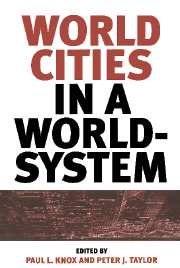Book contents
- Frontmatter
- Contents
- List of contributors
- Preface
- Part 1 Introduction: world city, hypothesis and context
- 1 World cities in a world-system
- 2 Where we stand: a decade of world city research
- 3 World cities and territorial states: the rise and fall of their mutuality
- 4 On concentration and centrality in the global city
- Part 2 Cities in systems
- Part 3 Politics and policy in world cities: theory and practice
- Appendix The world city hypothesis
- Index
4 - On concentration and centrality in the global city
Published online by Cambridge University Press: 07 October 2009
- Frontmatter
- Contents
- List of contributors
- Preface
- Part 1 Introduction: world city, hypothesis and context
- 1 World cities in a world-system
- 2 Where we stand: a decade of world city research
- 3 World cities and territorial states: the rise and fall of their mutuality
- 4 On concentration and centrality in the global city
- Part 2 Cities in systems
- Part 3 Politics and policy in world cities: theory and practice
- Appendix The world city hypothesis
- Index
Summary
Place and production in the global economy
One of the central concerns in my work has been to look at cities as production sites for the leading service industries of our time, and hence to recover the infrastructure of activities, firms, and jobs that is necessary to run the advanced corporate economy. Specialized services are usually understood in terms of specialized outputs rather than the production process involved. A focus on the production process in service industries allows us (a) to capture some of the locational characteristics of these industries; and (b) to examine the proposition that there is a producer services complex which, while catering to corporations, has distinct locational and production characteristics. It is this producer services complex more so than headquarters of firms generally that benefits and often needs a city location.
We see this dynamic for agglomeration operating at different levels of the urban hierarchy, from the global to the regional. At the global level, a key dynamic explaining the place of major cities in the world economy is that they concentrate the infrastructure and the servicing that produce a capability for global control. The latter is essential if geographic dispersal of economic activity — whether factories, offices, or financial markets — is to take place under continued concentration of ownership and profit appropriation.
- Type
- Chapter
- Information
- World Cities in a World-System , pp. 63 - 76Publisher: Cambridge University PressPrint publication year: 1995
- 76
- Cited by

